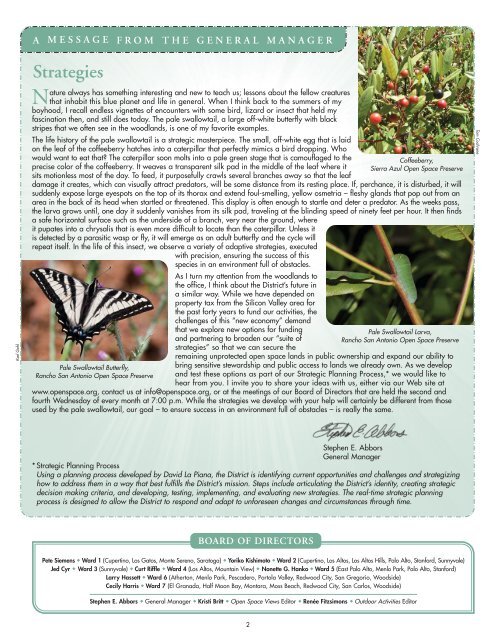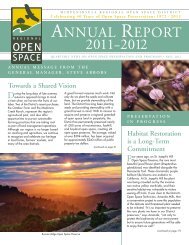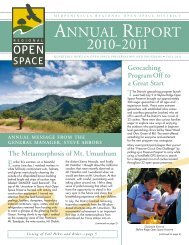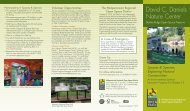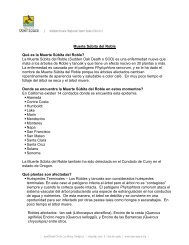Layout 1 (Page 2) - Midpeninsula Regional Open Space District
Layout 1 (Page 2) - Midpeninsula Regional Open Space District
Layout 1 (Page 2) - Midpeninsula Regional Open Space District
Create successful ePaper yourself
Turn your PDF publications into a flip-book with our unique Google optimized e-Paper software.
Karl Gohl<br />
A MESSAGE FROM THE GENERAL MANAGER<br />
Strategies<br />
Nature always has something interesting and new to teach us; lessons about the fellow creatures<br />
that inhabit this blue planet and life in general. When I think back to the summers of my<br />
boyhood, I recall endless vignettes of encounters with some bird, lizard or insect that held my<br />
fascination then, and still does today. The pale swallowtail, a large off-white butterfly with black<br />
stripes that we often see in the woodlands, is one of my favorite examples.<br />
The life history of the pale swallowtail is a strategic masterpiece. The small, off-white egg that is laid<br />
on the leaf of the coffeeberry hatches into a caterpillar that perfectly mimics a bird dropping. Who<br />
would want to eat that? The caterpillar soon molts into a pale green stage that is camouflaged to the<br />
precise color of the coffeeberry. It weaves a transparent silk pad in the middle of the leaf where it<br />
sits motionless most of the day. To feed, it purposefully crawls several branches away so that the leaf<br />
damage it creates, which can visually attract predators, will be some distance from its resting place. If, perchance, it is disturbed, it will<br />
suddenly expose large eyespots on the top of its thorax and extend foul-smelling, yellow osmetria – fleshy glands that pop out from an<br />
area in the back of its head when startled or threatened. This display is often enough to startle and deter a predator. As the weeks pass,<br />
the larva grows until, one day it suddenly vanishes from its silk pad, traveling at the blinding speed of ninety feet per hour. It then finds<br />
a safe horizontal surface such as the underside of a branch, very near the ground, where<br />
it pupates into a chrysalis that is even more difficult to locate than the caterpillar. Unless it<br />
is detected by a parasitic wasp or fly, it will emerge as an adult butterfly and the cycle will<br />
repeat itself. In the life of this insect, we observe a variety of adaptive strategies, executed<br />
with precision, ensuring the success of this<br />
species in an environment full of obstacles.<br />
Pale Swallowtail Butterfly,<br />
Rancho San Antonio <strong>Open</strong> <strong>Space</strong> Preserve<br />
As I turn my attention from the woodlands to<br />
the office, I think about the <strong>District</strong>’s future in<br />
a similar way. While we have depended on<br />
property tax from the Silicon Valley area for<br />
the past forty years to fund our activities, the<br />
challenges of this “new economy” demand<br />
that we explore new options for funding<br />
and partnering to broaden our “suite of<br />
strategies” so that we can secure the<br />
remaining unprotected open space lands in public ownership and expand our ability to<br />
bring sensitive stewardship and public access to lands we already own. As we develop<br />
and test these options as part of our Strategic Planning Process,* we would like to<br />
hear from you. I invite you to share your ideas with us, either via our Web site at<br />
www.openspace.org, contact us at info@openspace.org, or at the meetings of our Board of Directors that are held the second and<br />
fourth Wednesday of every month at 7:00 p.m. While the strategies we develop with your help will certainly be different from those<br />
used by the pale swallowtail, our goal – to ensure success in an environment full of obstacles – is really the same.<br />
Stephen E. Abbors<br />
General Manager<br />
* Strategic Planning Process<br />
Using a planning process developed by David La Piana, the <strong>District</strong> is identifying current opportunities and challenges and strategizing<br />
how to address them in a way that best fulfills the <strong>District</strong>’s mission. Steps include articulating the <strong>District</strong>’s identity, creating strategic<br />
decision making criteria, and developing, testing, implementing, and evaluating new strategies. The real-time strategic planning<br />
process is designed to allow the <strong>District</strong> to respond and adapt to unforeseen changes and circumstances through time.<br />
BOARD OF DIRECTORS<br />
Pete Siemens ◆ Ward 1 (Cupertino, Los Gatos, Monte Sereno, Saratoga) ◆ Yoriko Kishimoto ◆ Ward 2 (Cupertino, Los Altos, Los Altos Hills, Palo Alto, Stanford, Sunnyvale)<br />
Jed Cyr ◆ Ward 3 (Sunnyvale) ◆ Curt Riffle ◆ Ward 4 (Los Altos, Mountain View) ◆ Nonette G. Hanko ◆ Ward 5 (East Palo Alto, Menlo Park, Palo Alto, Stanford)<br />
Larry Hassett ◆ Ward 6 (Atherton, Menlo Park, Pescadero, Portola Valley, Redwood City, San Gregorio, Woodside)<br />
Cecily Harris ◆ Ward 7 (El Granada, Half Moon Bay, Montara, Moss Beach, Redwood City, San Carlos, Woodside)<br />
Stephen E. Abbors ◆ General Manager ◆ Kristi Britt ◆ <strong>Open</strong> <strong>Space</strong> Views Editor ◆ Renée Fitzsimons ◆ Outdoor Activities Editor<br />
2<br />
Coffeeberry,<br />
Sierra Azul <strong>Open</strong> <strong>Space</strong> Preserve<br />
Pale Swallowtail Larva,<br />
Rancho San Antonio <strong>Open</strong> <strong>Space</strong> Preserve<br />
Tom Cochrane


